The Corsair Carbide 600Q Case Review: Upside Down But Right On
by E. Fylladitakis on September 12, 2016 8:30 AM EST- Posted in
- Cases/Cooling/PSUs
- Corsair
- ATX
- E-ATX
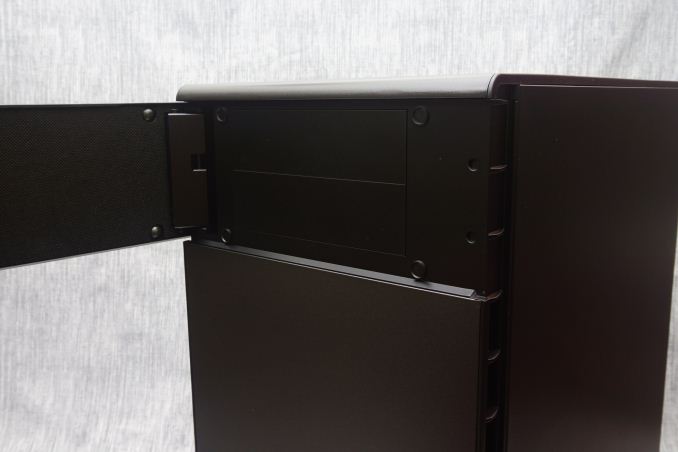
The concept of reversed and rotated motherboard tray cases is not new. Such designs primarily received attention with the introduction of the BTX form factor, when manufacturers were trying to make their products both ATX and BTX compatible. The prime example is probably the first generation Cooler Master Stacker, both for its design and what followed. The Stacker was successful enough to spawn a whole family of cases, however none of them retained the original's reversable tray. And, as things turned out, that's an accurate reflection of the larger market: ever since the BTX form factor has been abandoned, there are very few cases with rotated and reversed motherboard trays. Those few cases that still offer alterable trays are considered unordinary, special designs.
Introduction
It is just such a special case that we are taking a look at in this review: the Corsair Carbide 600Q Inverse ATX case. Corsair introduced the Carbide 600Q as a high quality product that is focused on utility and low-noise operation. The primary attraction of this case however is its interior design. As the name suggests, the Carbide 600Q has an inversed motherboard tray that, according to the company, should enhance the thermal performance of the system. It goes without saying then that we'll be paying special attention to that claim for this review, and seeing how it compares against typical ATX designs.
| Corsair Carbide 600Q | ||
| Motherboard Size | EATX, ATX, Micro-ATX, Mini-ITX | |
| Drive Bays | External | 2 × 5.25" |
| Internal | 2 × 3.5" 3 × 2.5" |
|
| Cooling | Front | 2 × 120 mm or 2 x 140 mm (2 × 140 mm included) |
| Rear | 1 × 140 mm (included) | |
| Top | - | |
| HDD | - | |
| Bottom | 3 × 120 mm or 2 x 140 mm (not included) | |
| Radiator Support | Front | Up to 280 mm |
| Rear | Up to 140 mm | |
| Top | - | |
| Side | - | |
| Bottom | Up to 360 mm | |
| I/O Port | 2× USB 3.0, 2× USB 2.0, 1× Headphone, 1× Mic | |
| Power Supply Size | ATX | |
| Clearances | HSF | 200 mm |
| PSU | 210 mm | |
| GPU | 370 mm | |
| Dimensions | 535 mm × 260 mm × 454 mm 21.06 in × 10.24 in × 17.87 in |
|
| Prominent Features | · Inverse ATX Layout: With this new layout, airflow is directed at the hottest devices in your system; the GPU and CPU, and not wasted on drive cages. · (Windowed Version Only): Full side panel window: A gorgeous, panoramic full side panel window shows off your components, and the tool-free latch and hinge lets you get in and out of the case easily. · Steel Exterior: Get rid of those plastic cases - the 600C has full steel front and top panels for extra durability and good looks. · Three included AF140L fans: Great airflow doesn't have to be noisy. The AF140L fans can push good amounts of air across your hottest devices with less distracting fan hum, and the three-speed fan controller lets you decide exactly how fast they run. · PSU and 5.25" Bay Cover: Clean up the inside of your case by tucking all those cables and less-attractive drives behind a clean, refined PSU and 5.25" bay cover. Or remove them for assembly - it's up to you. · Water-cooling Ready: Fit up to a 280mm radiator up front and up to a 360mm radiator on the bottom - along with the 140mm rear fan mount, that means your next build can be both cool and beautiful. · Easy to Clean: Easy-access dust filters on the front and bottom mean you'll never spend more than a minute getting dust out of your system. · Easy to Build: Tool-free drive installation, side panel access, and tons of cable routing options and tie downs means you can spend less time building your PC and more time using it. |
|
| Price | $140 | |
Packaging & Bundle
Corsair supplies the Carbide 600Q in a monochromic and aesthetically simple, but very sturdy cardboard box. The case is well protected inside it by two thick Styrofoam slabs and a nylon bag.
The company kept the main bundle of the case down to the basics. Only the necessary black mounting hardware, a manual and a few short cable ties are supplied alongside with the 600Q.
By default, the case has two 140 mm fans installed. A third 140 mm fan however is supplied along with the case, packed along with its mounting screws and a thank you note inside a small box. The user can decide the mounting location of this 140 mm fan, or choose not to install it at all in favor of lower noise levels.


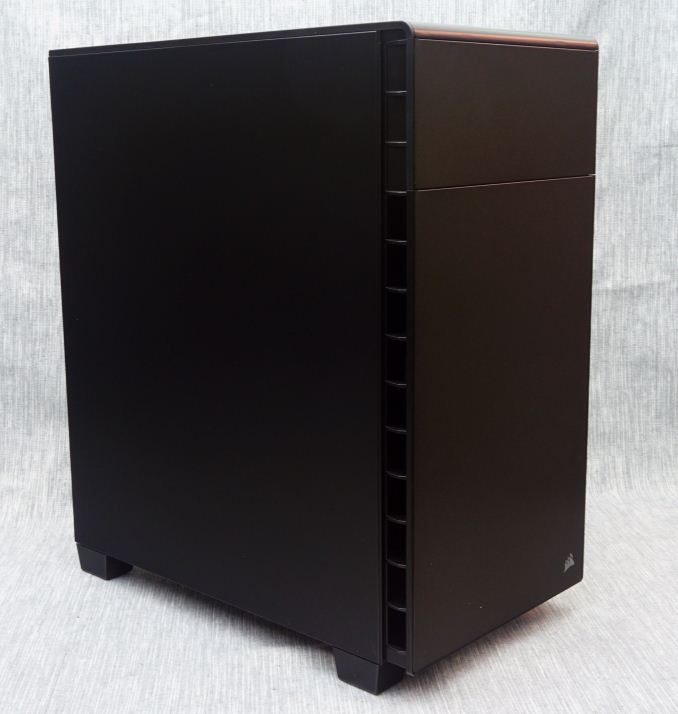
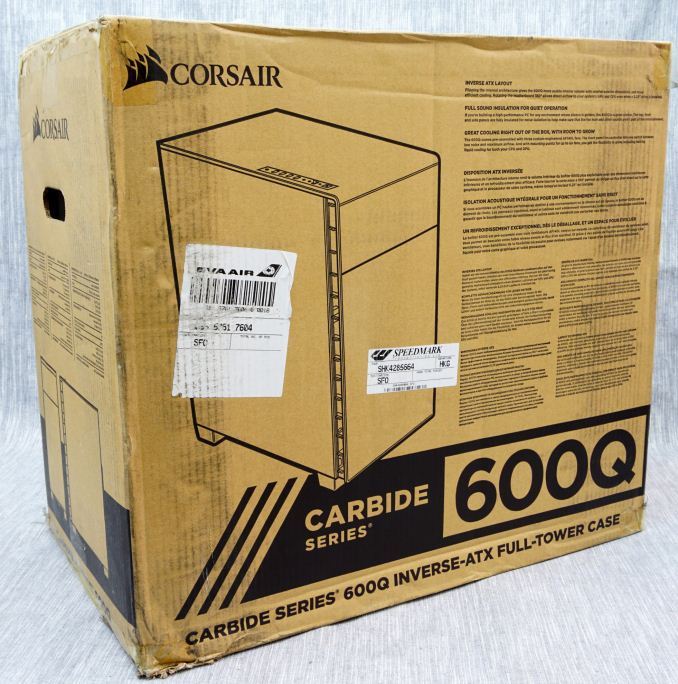
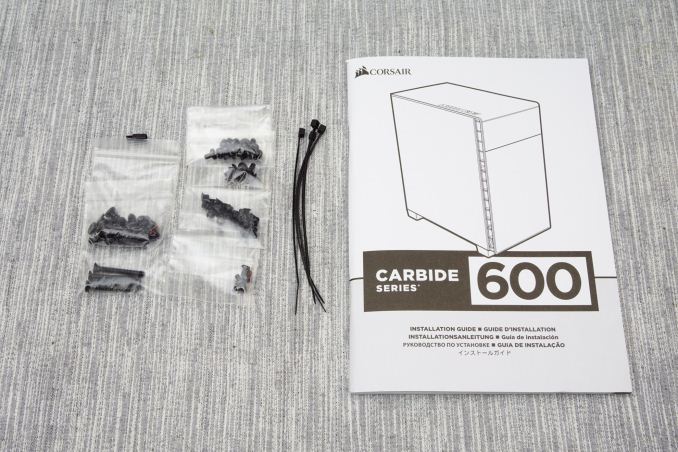
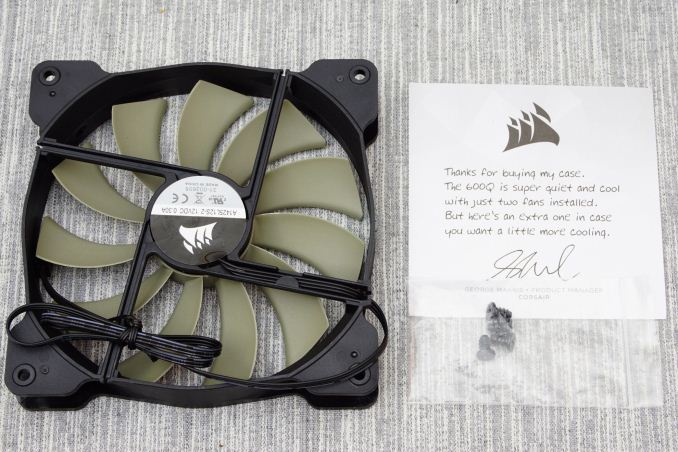








46 Comments
View All Comments
Ej24 - Monday, September 12, 2016 - link
Holy crap, I nearly forgot my first computer, an eMachines 633ids. Thank you for this nostalgic moment.justaviking - Monday, September 12, 2016 - link
Where is the panoramic window?In the table on page 1, the second Prominent Feature is "Full side panel window: A gorgeous, panoramic full side panel window shows off your components..."
I kept looking for a picture of that great feature.
Ryan Smith - Monday, September 12, 2016 - link
There are two versions of the case, an opaque version and a windowed version. We have the opaque version. The feature list comes from Corsair, so I've tweaked it just a bit to make it clear that there are multiple versions.Houdani - Monday, September 12, 2016 - link
Three cheers for the non-window version. Case Makers: More please.fmyhr - Monday, September 12, 2016 - link
Exposed top-panel ports: recipe for poor connections due to dust collection. I suppose some electrical tape over unused ports would fit right in with the "carbide" look. ;-)madwolfa - Monday, September 12, 2016 - link
Looks like a larger version of SilverStone TJ08-E, which is probably a good thing. And yeah, the interior design (PSU orientation, etc) is nothing new.DanNeely - Monday, September 12, 2016 - link
Are the thermal tests actually passive as captioned in the graphs, or are they with the case fans running as implied by the text? If the former, where are the actively cooled thermal graphs.Ryan Smith - Monday, September 12, 2016 - link
The case fans are running. It's the heat load itself that's passive.DanNeely - Monday, September 12, 2016 - link
Is that the same setup used for the Graphite 760 and Deep Silence 6 tests that this case is compared to; which don't have the word passive on their graphs.The lack of fans on E.Fyll's test heaters is a separate issue. It doesn't matter much with large enthusiast cases with several pre-installed fans. The problem is the other end of the market where his test methodology makes cases designed around smaller quieter setups whose lack of pre-installed fans indicates they were either designed to use the fans on the PSU, CPU heatsink, and optionally a blower style GPU cooler to dissipate heat look much worse than they would in a more realistic setup.
E.Fyll - Wednesday, September 14, 2016 - link
It is the same setup. We just improved the graphs to provide more information and be aesthetically appealing.We are intentionally using a passive thermal load. This is not an issue at all; on the contrary, any form of active cooling would affect the results dissimilarly for each given design. With a fully passive load, we determine how the case performs unaffected by external parameters (as far as that is possible, of course). If we were using active cooling that would induce airflow to "assist" a case that cannot provide sufficient airflow over a certain area, we would be essentially fabricating the results. We are testing the case itself, not a predetermined system as a whole.
The cases that you mention do not "look" much worse than they would in a more realistic setup. They are much worse. In the scenarios that you describe, thermal energy will not disappear, it will move through the components that they have been designed to be cooling only themselves. When a case has been designed with its cooling depending on parts that are not supposed to be "assisting the case", the thermal performance of that specific part dives. For example, if a case has been designed so as to "depend on the PSU's fan", the PSU will have to extract the extra thermal energy that the case cannot. It will get hotter, louder and the thermal performance of the whole area will depend on the specific cooling capabilities of the PSU, just because the case cannot extract the heat by itself. Will it work? Yes (well, probably). Does it perform just as well as a case that can extract the thermal energy all by itself? Absolutely not.